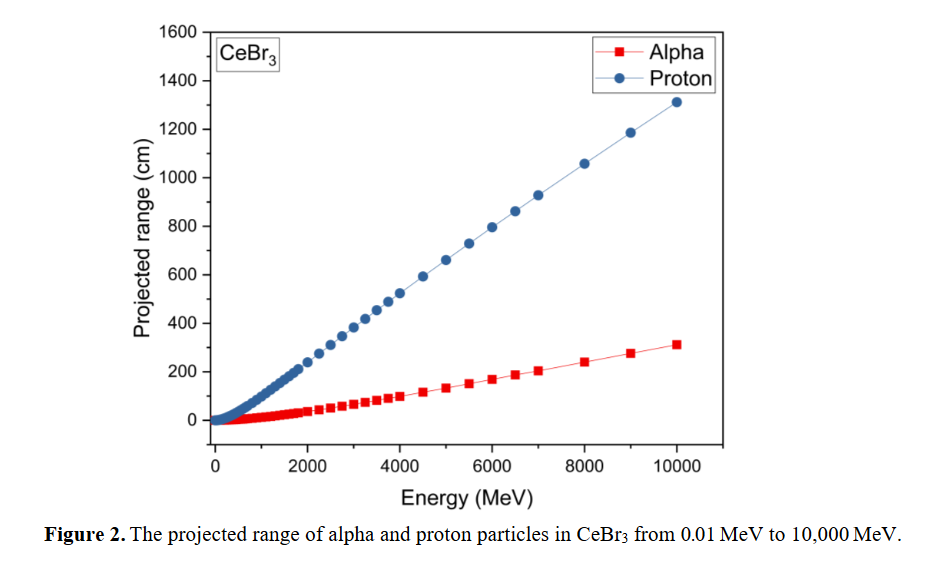Investigation of charged particles interaction with CeBr3 scintillator by Monte Carlo simulation programs
DOI:
https://doi.org/10.53848/ssstj.v11i1.594Keywords:
CeBr3 scintillator, Monte Carlo simulation, Alpha, ProtonAbstract
This work aims to investigate the interaction of charged particles (alpha and proton) with the CeBr3 scintillator by using Monte Carlo simulation. The total mass stopping power (TMSP), projected range, ion distributions, and ion ranges in the CeBr3 at an energy range of 0.01 - 10,000 , were computed by SRIM and FLUKA programs. The simulation results show that the TMSP of CeBr3 obtained by both programs is in good agreement. The alpha particle has a higher TMSP of the CeBr3 than the proton. The projected range of alpha and proton particles increases with increasing energy. The projected range of the proton is higher than that of the alpha particle when compared at the same energy. Finally, the 2D visualization of ion distributions and ion ranges for alpha and proton particles was reported.
References
Ahdida, C., Bozzato, D., Calzolari, D., Cerutti, F., Charitonidis, N., Cimmino, A., ... Widorski, M. (2022). New capabilities of the FLUKA multi-purpose code. Frontiers in Physics, 9, 788253.doi:10.3389/fphy.2021.788253
Allison, J., Amako, K., Apostolakis, J., Arce, P., Asai, M., Aso, T., … Yoshida, H. (2016). Recent developments in GEANT4. Nuclear Instruments and Methods in Physics Research, Section A: Accelerators, Spectrometers, Detectors and Associated Equipment, 835, 186-225. doi:10.1016/j.nima.2016.06.125
Battistoni, G., Boehlen, T., Cerutti, F., Chin, P. W., Esposito, L. S., Fassò, A., ... Smirnov, G. (2015). Overview of the FLUKA code. Annals of Nuclear Energy, 82, 10-18. doi:10.1016/j.anucene.2014.11.007
Braibant, S., Giacomelli, G., & Spurio, M. (2012). Particles and fundamental interactions. Dordrecht: Springer.
El-Ghossain, M. O. (2017). Calculations of stopping power, and range of ions radiation (alpha particles) interaction with different materials and human body parts. International Journal of Physics, 5(3), 92-98.
Giaz, A., Hull, G., Fossati, V., Cherepy, N., Camera, F., Blasi, N., ... Riboldi, S. (2015). Preliminary investigation of scintillator materials properties: SrI2:Eu, CeBr3 and GYGAG:Ce for gamma rays up to 9 MeV. Nuclear Instruments and Methods in Physics Research Section A: Accelerators, Spectrometers, Detectors and Associated Equipment, 804, 212-220. doi:10.1016/j.nima.2015.09.065
Idoeta, R., Herranz, M., Alegría, N., & Legarda, F. (2021). Possibilities of the use of CeBr3 scintillation detectors for the measurement of the content of radionuclides in samples for environmental monitoring. Applied Radiation and Isotopes, 176. doi:10.1016/j.apradiso.2021.109881
Naqvi, A. A., Khiari, F. Z., Liadi, F. A., Khateeb-ur-Rehman, & Isab, A. A. (2016). Performance tests of a large volume cerium tribromide (CeBr3) scintillation detector. Applied Radiation and Isotopes, 114, 50-56.doi:10.1016/j.apradiso.2016.04.031
Sato, T., Iwamoto, Y., Hashimoto, S., Ogawa, T., Furuta, T., Abe, S. I., ... Niita, K. (2018). Features of particle and heavy ion transport code system (PHITS) version 3.02. Journal of Nuclear Science and Technology, 55(6), 684-690. doi:10.1080/00223131.2017.1419890
Swiderski, L., Moszynski, M., Syntfeld-Kazuch, A., Szawlowski, M., & Szczesniak, T. (2014). Measuring the scintillation decay time for different energy depositions in NaI:Tl, LSO:Ce and CeBr3 scintillators. Nuclear Instruments and Methods in Physics Research Section A: Accelerators, Spectrometers, Detectors and Associated Equipment, 749, 68-73. doi:10.1016/j.nima.2014.02.045
Vahabi, S. M., & Shamsaie Zafarghandi, M. (2020). Applications of MCNP simulation in treatment planning: A comparative study. Radiation and Environmental Biophysics, 59(2), 307-319. doi:10.1007/s00411-020-00841-2
Ziegler, J. F., Ziegler, M. D., & Biersack, J. P. (2010). SRIM–The stopping and range of ions in matter (2010). Nuclear Instruments and Methods in Physics Research Section B: Beam Interactions with Materials and Atoms, 268(11-12), 1818-1823. doi:10.1016/j.nimb.2010.02.091

Downloads
Published
How to Cite
Issue
Section
License
Copyright (c) 2024 Suan Sunandha Rajabhat University

This work is licensed under a Creative Commons Attribution 4.0 International License.











